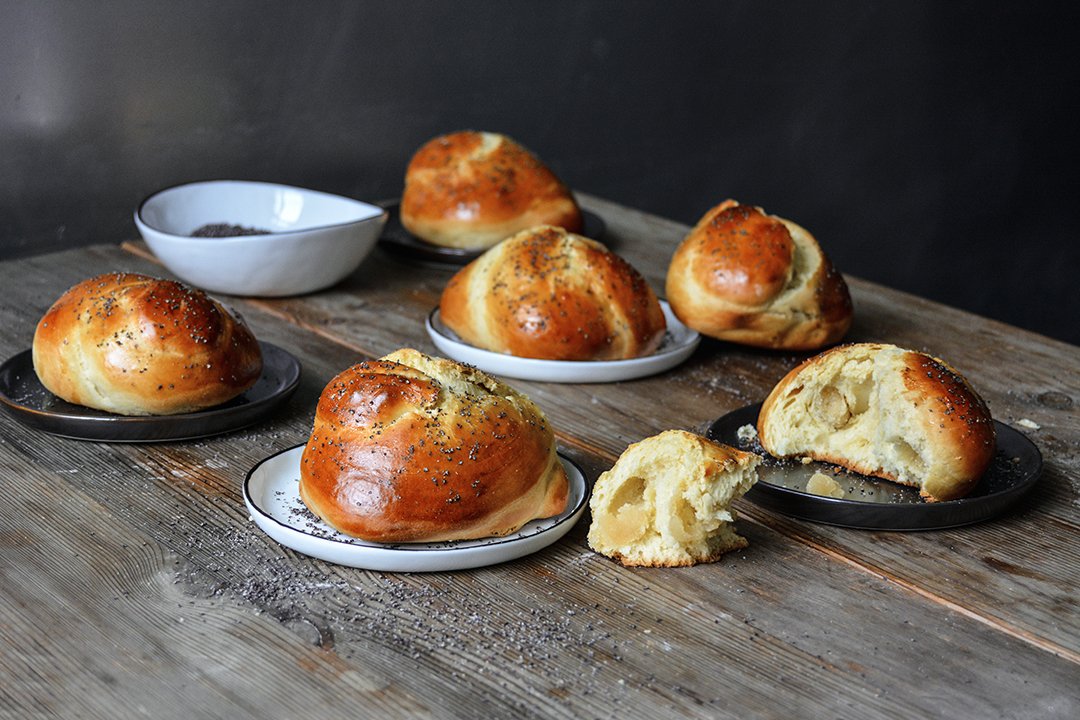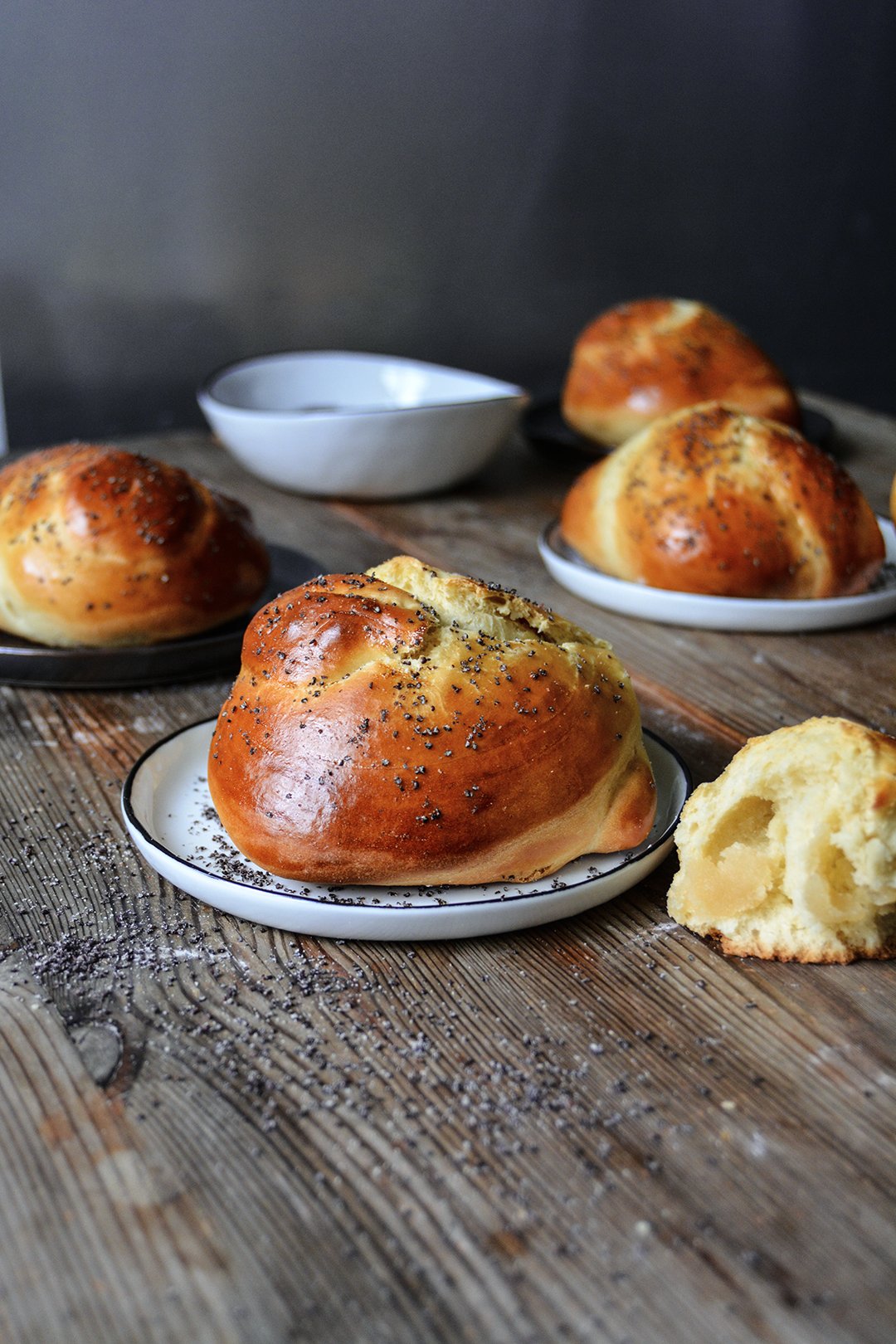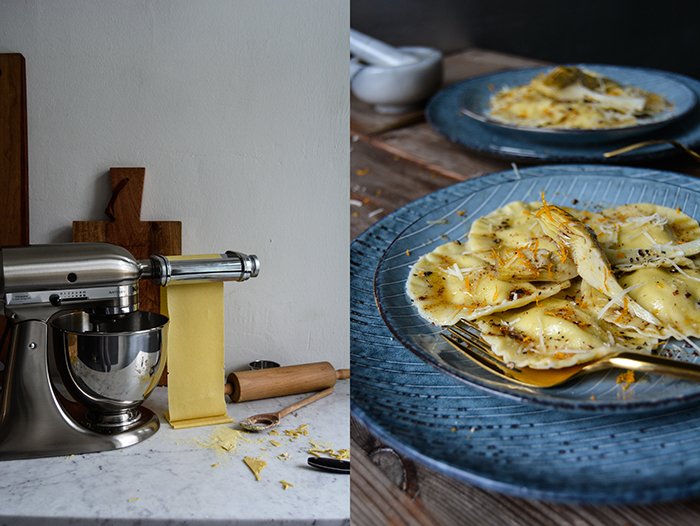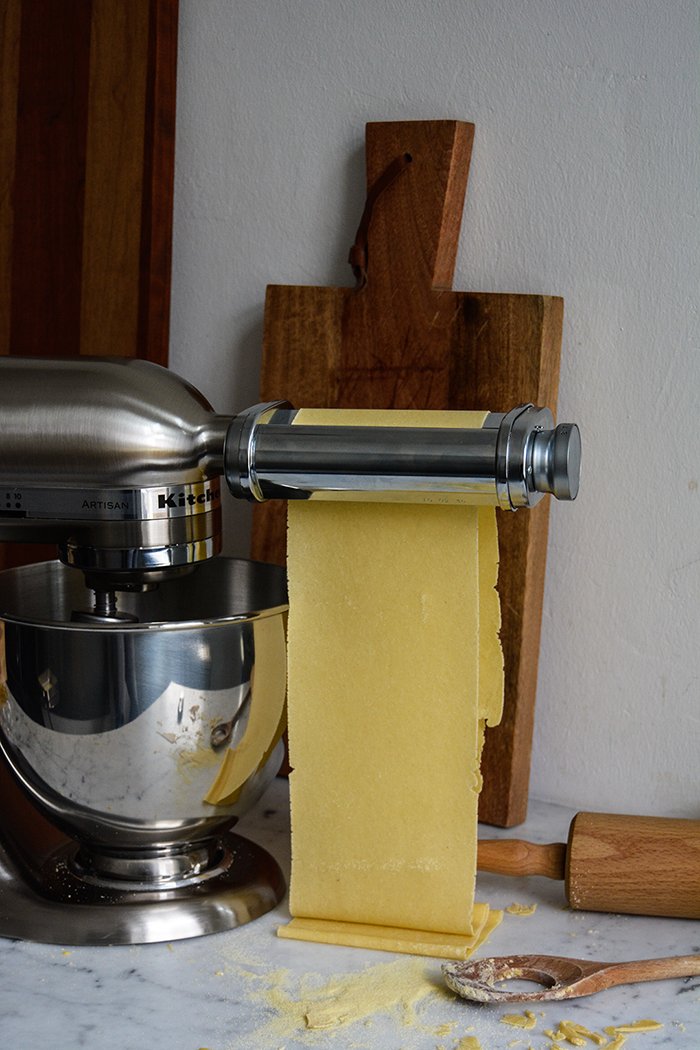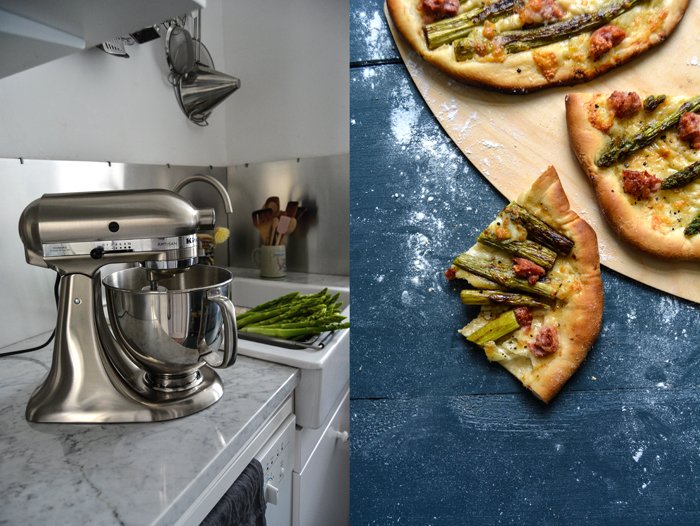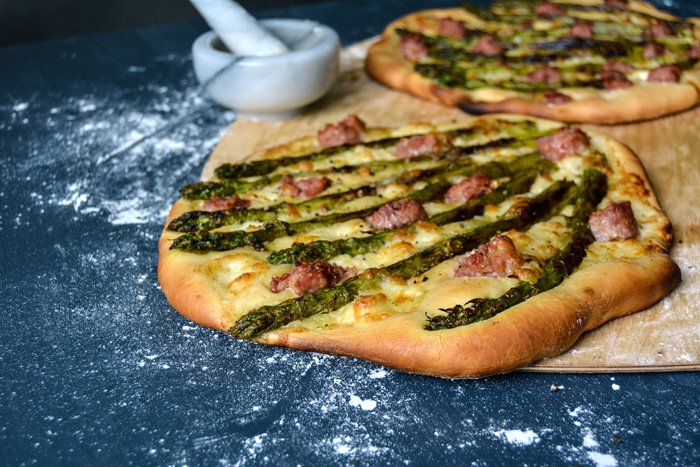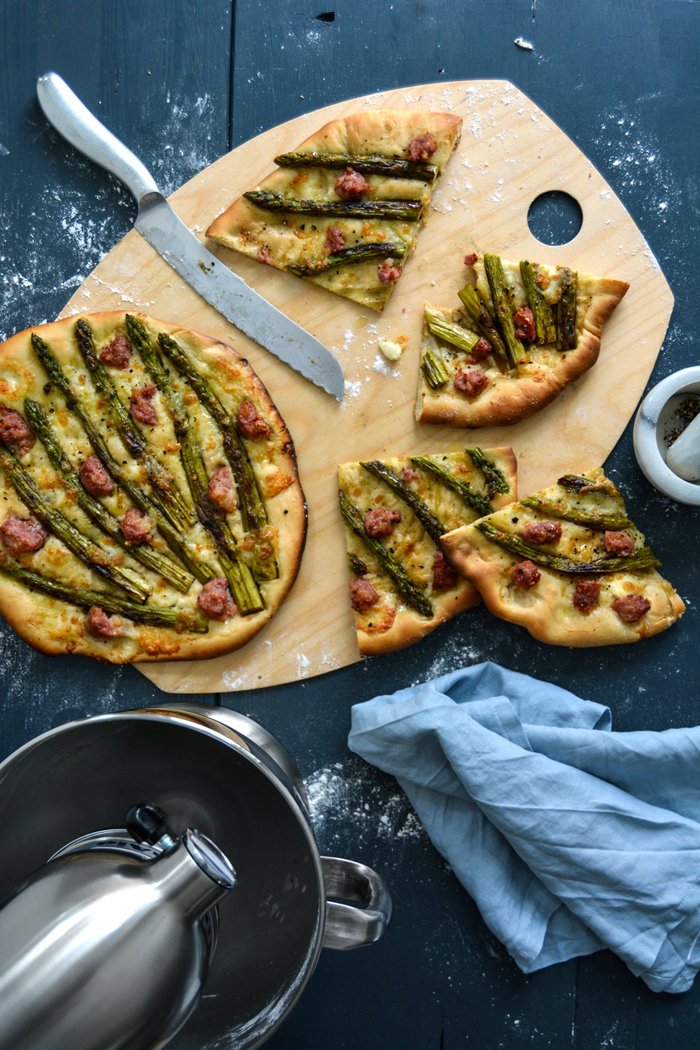Laurel Kratochvila's Marzipan-Ribboned Challah Knots
I don't even remember how it started. It must have been a few years ago when my man and I welcomed a new tradition: coffee dates. Whenever we find time to take an hour off work, we squeeze in a dark Italian espresso or a creamy cappuccino, happily enjoyed in one of the countless cafés in our area. And on Saturdays - overly excited by the luxury of having plenty of free time - we often stretch it into a lunch-teatime-aperitif date. Just the two of us, chatting about whatever's on our mind, no plans or duties, just lingering until we decide to move on.
On one of these dates, we went to the new Shakespeare and Sons / Fine Bagels. The book shop and bakery used to be close to where we live, but the two owners, Roman and Laurel, had to transfer their cafe and literature business to a new location. That was the first time I tried Laurel's absolutely outstanding chocolate rugelach, which blew my mind and made me want (or rather have to) meet the woman behind this treat.
When we met, our chat led to a Meet In Your Kitchen feature (including my beloved rugelach recipe), but most importantly, I found a woman who's a great inspiration. Laurel loves food, she's obsessed with baking, she's gifted with an unbelievable amount of energy, and when you talk to her, you can see her beautiful soul. She's honest, critical, and crazy enough to overcome her fears and jump into the next adventure. Nosh Berlin is her new baby, a Jewish food week, starting March 17th. It'll be a week packed with talks, feasts, and Jewish food. I already booked my tickets for two events, Molly Yeh is coming on the 22nd and I didn't dare to miss The Gefilte Ball on Thursday. You can find the program of all the events below or on the Nosh Berlin website.
When I met Laurel for a coffee a couple weeks ago to hear everything about her exciting events, I nibbled on my obligatory rugelach and she chose a new creation, her current obsession: a marzipan-ribboned challah knot. She looked so happy whenever she took a bite of her yeast bun that I thought, I need this recipe. Laurel is a nice person who loves to share, I didn't even need to beg her. And here it is, fluffy yeast buns, not too sweet, generously filled with marzipan, and so good, that I ate five of them in a day and a half. Laurel only uses egg yolks, melted butter, and water in this recipe. She uses bread flour, however I replaced it with white spelt flour that comes to use in all of my baking recipes. I had to add a little more flour and I think that a bit more wouldn't have harmed the texture, but helped the knots to keep their shape a bit better and avoided cracks on the surface. As you can see in the pictures, my knots turned into roundish buns in the oven. I didn't mind, challah knot or bun, I love Laurel's latest creation.
Nosh Food Festival
- Friday, March 17th - Kiddush: North African Jewish dinner by Yuval Belhans and Mayaan Meir
- Sunday, March 19th - The Nosh Market at Markthalle Neun Oma and Bella: Movie and a Nosh at Babylon Berlin
- Monday, March 20th - The JCC Krakow presents Jewish Polish Food History. Talk and a tasting
- Tuesday, March 21st - What Jew Wanna Eat? Amy Kritzer, visiting chef from Austin, Texas, presents creative Passover cooking.
- Wednesday, March 22nd - Molly Yeh and Luisa Weiss: Cookbooks, Blogs, and Jewish Baking
- Thursday, March 23rd - Nosh Berlin and Shtetl Neukölln present The Gefilte Ball. Talk and demo with Jeffrey Yoskowitz of The Gefilte Manifesto followed by a klezmer ball.
- Friday, March 24th: Night of Shabbat Supper Clubs
There will also be a couple talks on various Jewish food topics at the Fraenkelufer Synagogue and a showing of Cafe Nagler with a presentation on pre-war Jewish cafe and restaurant life. Additionally, there are Jewish cookery classes all week at Goldhahn and Sampson in Charlottenburg.
Marzipan-Ribboned Challah Knots
If you decide to double the recipe, use only 9 egg yolks, which is Laurel's original recipe.
Makes 7 challah knots
organic egg yolks 5, plus 1 egg white, beaten, for the glaze
butter, melted and cooled, 40g / 3 tablespoons
water 175ml /3/4 cup
bread flour (or white spelt or unbleached wheat flour), 410-480g (3 cups plus 2 tablespoons - 3 2/3 cups), plus more if the dough is too sticky
granulated sugar 100g / 1/2 cup
fast-acting yeast 1 1/4 teaspoons
fine sea salt 1 teaspoon
marzipan, cut into 7 pieces, 150g / 5 ounces
poppy seeds 1 tablespoon, for the topping
In a medium bowl, whisk the egg yolks and butter. Add water and whisk until well combined.
In the large bowl of a stand mixer, whisk together the flour (410g / 3 cups plus 2 tablespoons), sugar, yeast, and salt. Add the liquid mixture and, using the paddle attachment, mix for about 1 minute until combined. Replace the paddle attachment with the dough hook and knead for about 10 minutes. I use setting ‘4’ on my KitchenAid. Add more flour if the dough is too sticky, but mind that it should stay soft. If you prepare the dough by hand, keep kneading an extra few minutes. Transfer to a clean, oiled bowl, cover with a kitchen towel and let rise in a warm place, or preferably in a 35°C / 100°F warm oven (conventional setting), for about 60-70 minutes or until spongy. When you poke the dough, the indentation of your finger shouldn't spring back.
Punch the dough down and then turn out onto a floured work surface. Give it a quick knead to form it back into a ball and then cut 7 equal pieces. Cover with a tea towel and let rest for about 15 minutes.
Line a baking sheet with parchment paper.
Once rested, roll the dough into logs (about 25cm / 10" long) and then gently press flat. Lay a strip of marzipan lengthwise down the middle of the flattened log (using my hands, I first rolled each piece of marzipan into a long log) and then fold the log lengthwise in half, so you have a marzipan-filled log (see first picture). To fold the log into a knot, make an overlapping circle and then wrap the upper end under and then up through the middle (see first picture).
Preheat the oven to 175°C / 350°F (convection setting).
Once all 7 knots are folded, transfer to the lined baking sheet and brush with the beaten egg white. Laurel puts a little simple syrup in the egg glaze to add some extra sweetness, I left mine plain. Let them rise for about 30 minutes or until puffy. Glaze the challah knots with egg whash a second time then sprinkle with poppy seeds.
Bake for about 20 minutes or until the challah knots are golden brown and shiny.
Tahini Date Cake with Whipped Cream
Welcome 2017! May you bring peace, love, and patience to our lives.
On one of the last days of 2016, we gathered a group of friends from Florence, Israel, and London around our long wooden dining table. To keep it cozy, I cooked Swabian Käsespätzle, the famous homemade egg noodles layered with lots and lots of cheese and soft, golden brown onions. This meal is so rich and comforting, it's perfect for a cold winter's night. I don't know a single person who doesn't find it addictive. Although it's a classic Southern German dish, I've heard quite a few Italians claiming that Italy is its true place of origin. However, my guests from Florence tried it for the first time and they were enraptured.
My guest from Israel inspired me to bake a cake with one of his home country's most popular products: tahini. I made a fruit cake, similar to an English teatime loaf, but I replaced the butter with tahini and olive oil. To say that it was good would be a total understatement. Light, with a soft hint of tahini, it was delicious, especially in combination with the chopped dates that I stirred into the dough and the sesame seeds sprinkled on top. I served this rustic looking beauty with lightly sweetened tahini whipped cream, we were all smitten.
Tahini Date Cake
Makes 1 cake
plain flour 260g / 2 cups
baking powder 1 tablespoon
freshly grated orange zest 1 tablespoon
ground cinnamon 1 teaspoon
fine sea salt 1/8 teaspoon
tahini, mixed well, 75ml / 1/3 cup
mild olive oil 75ml / 1/3 cup
whole milk 90ml / 1/3 cup plus 1 tablespoon
granulated sugar 200g / 1 cup
large organic eggs 4
pitted dates, roughly chopped, 100g / 3 1/2 ounces, plus a few chopped dates for serving
white sesame seeds 1 tablespoon, plus more for serving
For the tahini whipped cream
(the tahini whipped cream serves 4, you'll have to double the amount for the whole cake)
heavy cream 200ml / 3/4 cup plus 2 tablespoons
granulated sugar, to taste
tahini, mixed well, about 1 tablespoon
Preheat the oven to 180°C / 350°F (preferably convection setting) and butter a 20cm / 8″ springform pan.
In a large bowl, combine the flour, baking powder, orange zest, cinnamon, and salt.
In the bowl of a stand mixer, whisk together the tahini, olive oil, milk, sugar, and eggs for about 1 minute until well combined (I mix it on '4' on my KitchenAid). Stir in the flour mixture and continue mixing until no traces of flour are left. Stir in the dates and pour the dough into the prepared springform pan. Sprinkle with the sesame seeds and bake for about 45 minutes or until golden and spongy. Check with a skewer, it should come out almost clean. Let the cake cool for a few minutes and take it out of the pan.
Whip the cream with a little sugar until stiff, adjust sweetness to taste. Add the tahini and whip for a few seconds until well combined. To serve the cake, cut it into large pieces, add a generous dollop of the tahini whipped cream, and sprinkle with chopped dates and additional sesame seeds.
Wrapped in cling film, this cake stays moist for a couple days.
Artichoke, Ricotta and Orange Ravioli
If you decide to make your own homemade pasta, be prepared that you'll never be able to eat store bought pasta again (you'll feel less satisfied with it at the very least) - and that you won't feel your arms and abs for a couple days. To knead the dough by hand is necessary and labor-intensive. I had moments when I felt slight doubts about whether the crumbly mixture in front of me would ever turn into a smooth ball, but it worked. I needed all my patience and muscle power to get there, but the result tasted so good that I'd do it all over again (after my muscles got some rest).
My pasta project started last Friday and ended on Saturday afternoon. I first tried a recipe by Sicilian chef Dario Cammarata who only uses plain flour, durum wheat semolina, salt, egg yolks, and olive oil. The result tasted amazing, but getting there was so much harder than what I remembered from when I visited the chef in his kitchen in Frankfurt earlier this year. What seemed so easy in Darios's hands, didn't want to work as smoothly in my own.
Dario taught me that ravioli are best when they are made with egg yolks and not whole eggs. I have no doubt that this is true, the texture is light and perfectly al dente. But to knead my own dough made of 10 egg yolks, flour, and semolina almost made me cry. The mixture was so hard and fragile, I needed an alternative that was less stressful. I still used my egg yolk dough to make a few ravioli, which were perfect, and I made tagliatelle. And these were the best tagliatelle of my life - taste, texture, and thickness were spot on!
Early the next morning I went back to my kitchen. More eggs in the bowl (this time including the egg whites), with a fresh and open mind and a quenchless appetite for fresh pasta, I felt optimistic. Kneading the dough still required some serious muscle power (maybe it's just me, my arms are not the strongest), but it was manageable. And this time I totally enjoyed pulling the thin layers of fresh pasta through my KitchenAid pasta attachment. I needed about two test sheets, but then I was in business. They were so thin that I could see my hand through them.
For my first homemade ravioli, I chose a filling that still allowed me to enjoy the fine taste of the egg pasta. After all this work it didn't feel right to knock it out. The combination of preserved artichokes and fresh ricotta refined with a little orange zest was just right, present, but not overpowering. I served it with melted butter and golden artichoke hearts, briefly seared in the sizzling fat. A little crushed pepper and some more orange zest, and my work was done.
My KitchenAid has three pasta attachments and I'm particularly fond of the tagliatelle cutter. Once I was done with the ravioli, all the shorter pieces and leftover dough went through this attachment and they were perfectly cut into the thinest, tastiest pasta. Cook it al dente and add a knob of butter, freshly grated aromatic hard cheese, and black pepper, and you'll have the best meal ever. Buon appetito!
Artichoke, Ricotta and Orange Ravioli
Homemade ravioli are time and labour-intensive. They are a great starter or main dish for a dinner party, but I recommend preparing them a day in advance to keep it stress free. Freeze them (uncooked) and cook them in boiling salted water just before serving for 4 minutes. I recommend using a pasta machine for this recipe.
Makes 20-24 ravioli / serves 2-4
For the pasta dough
plain flour 150g / 1 cup plus 2 tablespoons
durum wheat semolina 150g / 5 1/4 ounces
fine sea salt 1/4 teaspoon
large organic eggs 3 plus 1 egg yolk
olive oil 1 tablespoon plus 1 teaspoon
water, cold, 1 tablespoon
For the filling
preserved artichoke hearts, drained and squeezed, 160g / 6 ounces
fresh ricotta 125 g/ 4 1/2 ounces
olive oil 1 tablespoon
freshly grated Parmesan 25g / 1 ounce
a pinch of freshly grated orange zest
fine sea salt
ground pepper
For serving
butter 4 tablespoons
preserved artichoke hearts, drained and cut into 6 pieces each, 2
Parmesan
black peppercorns, crushed
a little orange zest
For the pasta dough, in the bowl of a stand mixer fitted with the dough attachment, combine the flour, semolina, and salt. Add the eggs, egg yolk, and olive oil and knead for about 5 minutes (I set it on '4' on my KitchenAid). If it's too dry, add 1 tablespoon of water, but not more. If it's too sticky, add a little semolina and flour. On the counter top or on a stable table, using your hands, continue kneading the dough for about 15 minutes until smooth. It will still be firm. I find it easiest to leave it in the shape of a thick disc for the first 5-7 minutes, punching and kneading it, and scraping the crumbs together. Then I knead it and roll it into a ball (see pictures below). Form a ball, wrap it in cling film, and let it rest in the fridge for 1 hour.
For the filling, purée the artichoke hearts, add to a bowl along with the ricotta, olive oil, Parmesan, orange zest, salt, and pepper. Whisk until smooth and adjust seasoning.
Divide the dough into 4-8 portions (depending on the width and power of your pasta machine). Roll out 1 portion with a rolling pin until it's thin enough to fit into your pasta machine. I started using position '1' on my pasta attachment, using the speed setting '2'. Pull the dough through the pasta machine twice, fold it in the middle, flatten it a little with the rolling pin if necessary, turn it 90°, and pull it through the pasta machine. Continue 2-3 times. Change to a thinner setting (I used '3') and pull the dough through the machine about 3 times, without folding it. Using a knife, straighten the sides of your pasta sheet and cut off excess dough. Continue using the thinner settings of your pasta machine until you can see your hand through the dough (I used '5' and then '6' at the end). If the dough is too sticky, use semolina, but no flour.
Sprinkle the rolled out pasta layer with semolina, fold it gently, and cover with cling film. Continue rolling the remaining dough.
Sprinkle a large baking sheet with semolina. Bring a large pot of generously salted water to the boil.
Lay out a layer of pasta and mark it with circles, using a 7cm / 3" round cutter (or whatever size and shape you prefer). Add a teaspoon of the filling in the middle of each marked circle. Dip your finger in water and wet the rim of the circles. From a second sheet of pasta, cut out circles of the same size, lay on top of the filling, and using your finger, push around the rim (see picture above). Using the cookie cutter, cut out the ravioli and press a little fork all around to seal the rim (see picture below). Transfer the ravioli to the prepared baking sheet.
In batches, cook the ravioli in the simmering water for about 2-3 minutes or until al dente.
To serve the ravioli, in a saucepan, heat the butter over high heat until golden brown, add the artichoke hearts, turn gently, and sauté for 1 minute.
Serve the ravioli sprinkled with the butter, Parmesan, orange zest (optional), and crushed pepper and lay the sautéed artichokes on top.
Fig, Chèvre and Honey Focaccia with Rosemary
My kitchen in Berlin faces a quiet backyard. In summer, I love to leave the windows wide open, hear the birds sing, and then it's often just me, alone with my thoughts and ideas, imagining ingredients, remembering old classics or coming up with new recipes. I get the cooker or oven started and my meditation begins: I just cook in silence.
Seeing that the weather hasn't shown the slightest hint of summer, I concentrated on rather hearty pleasures. I made cheese spaetzle (Southern German egg noodles with lots of melted cheese and golden onions), pasta with sautéed radicchio, chicken liver, and mustard butter, and enjoyed my obligatory Sunday pizza night. I also tried out a new cake recipe with the sweetest greengage plums, which was great, and I experimented with some dip variations. It was all very relaxing, calming, and put my mind at ease.
I also pulled one glorious - and much appreciated - dish out of my oven that combines all the fun of summer: a spongy, oily focaccia topped with ripe figs, soft chèvre, honey, and rosemary. It's perfect for breakfast, lunch, dinner or for a picnic - I could even have it at teatime with a cup of Darjeeling.
Fig, Chèvre and Honey Focaccia with Rosemary
Makes a 25 x 32cm / 10 x 12 1/2″ focaccia
For the dough
plain flour 500g / 3 3/4 cups plus 2 tablespoons
fast-acting yeast 1 (7g / 1/4 ounce) envelope
fine sea salt 1 teaspoon
granulated sugar 1 heaping teaspoon
water, lukewarm, 260ml / 1 cup and 2 tablespoons
olive oil 120ml / 1/2 cup, plus 1-2 tablespoons to oil the baking sheet
For the topping
honey 2 tablespoons
ripe figs, cut in half, 6
soft chèvre, torn into pieces, 150g / 5 ounces
fresh rosemary needles, a small handful
flaky sea salt
black peppercorns, crushed in a mortar (optional)
For the dough, combine the flour, yeast, salt, and sugar in the bowl of a stand mixer fitted with the dough hook. Add the lukewarm water and half the olive oil (60ml / 1/4 cup) and knead on medium-high speed for a few minutes until well combined. I mix it on '4' on my KitchenAid. If the dough is too sticky, add more flour. Transfer the dough to a table or countertop and continue kneading and punching it down with your hands for about 4 minutes or until you have a smooth and elastic ball of dough. Place the dough back in the mixer bowl, cover with a tea towel, and let rise in a warm place, or preferably in a 35°C / 100°F warm oven (conventional setting), for about 60 minutes or until doubled in size.
Oil a 25 x 32cm / 10 x 12 1/2″ baking sheet.
When the dough has doubled in size, punch it down, take it out of the bowl, and knead for 1 minute. Using your hands, stretch and spread the dough on the oiled baking sheet. Cover with a tea towel and let rise in a warm place for about 20 minutes or until puffy.
Preheat the oven to 220°C / 425°F (convection setting). Heat the honey in a saucepan over low heat for about 1 minute or until liquid.
Using the round bottom of a wooden spoon or your finger, punch around 6 x 7 holes into the surface of the dough. Pour the remaining olive oil over the dough and into the holes. Spread the figs (cut side up) over the focaccia and push them gently into the dough. Sprinkle with the chèvre, rosemary, and a little flaky sea salt, and drizzle with the warm honey. Bake for 20 minutes or until golden and light brown. Sprinkle with crushed pepper and enjoy warm or cold.
Pizza Bianca with Green Asparagus, Salsiccia, and Mozzarella di Bufala
I got my first KitchenAid and I feel like a little girl on Christmas Eve. To call the current mood in my kitchen excitement would be a serious understatement.
After years of seeing - and admiring - these sparkly, polished beauties in the kitchens of my friends and family (my sister has two!), the time had come to get my own. At a certain age, one deserves these special treats. I'm a strong believer that it's good to wait for things in life, it strengthens your character and makes you deeply appreciate what you have. But 20 years of waiting was more than enough, that's how long it took me to finally see this powerful stand mixer on my marble counter tops.
In various phases of my life, I always had my favourite KitchenAid colour. In my young twenties, I loved the creamy white surface, followed by a fascination for the 50s and its soft pastels. Light blue, mint, or pink, I would have taken any of them. Then I got into puristic minimalism and only a black mixer would have made it into my kitchen. In my thirties, I fell for light yellow, but now, all of a sudden, I had to make a decision and decide which colour I would finally get and see for the rest of my life. It wasn't easy and it took a few visits to various appliance shops. In the end, I had to weigh the advantages and disadvantages of cream, yellow, black, copper (which looks really hot), and brushed stainless steel. This process brought back lots of memories of the different eras of my life connected to each colour. After a couple weeks, my decision was made: brushed stainless steel is the winner! When the large package arrived I couldn't wait to see my object of desire on my counter tops - I was almost hysterical, which is excusable in my eyes, it's been 20 years after all. So here it is and it looks amazing. The mixer's metallic surface fits perfectly to my white marble and brushed aluminium wall panels. I'm totally in love and can't stop looking at it.
Testing its functionality was the next step, I had never used a KitchenAid before. My unbreakable hand mixer, a gift from my mother when I moved into my first flat two decades ago, has been a loyal partner during all my kitchen adventures. I was a little nervous and decided to start with two easy recipes - Sunday morning pancakes and Sunday evening pizza. This allowed me to get used to the three different attachments. My hand mixer only has two, but my new beauty offers a whisk, a paddle, and a hook - I needed a conference call with my sister to figure out when to use what.
Before I switched on the power, I had to call my boyfriend for this special moment. And this was our maiden voyage: I - rather the mixer - started beating the egg whites with such calm, persistence, and firm perfection that I thought I'd never touch my hand mixer ever again (sorry hand mixer). My next project - pizza dough - gave me the same satisfaction. The yeast dough was well mixed, smooth, and ready to be kneaded with my hands for a few minutes, which I always do to turn it into a soft and silky ball. I thought I'd use the time while the dough was getting mixed in the machine to prepare the toppings, however, I couldn't help but sit next to it with a glass of rosé wine in my hand and watch it work with elated enthusiasm.
Our first KitchenAid pizza was such a great success that I made another one only three days later, but this time it was an oily pizza bianca topped with green asparagus, Italian salsiccia, and mozzarella di bufala. On our latest Saturday leisure trip, we went to the food market at Markthalle Neun in Kreuzberg in Berlin and enjoyed a luscious piece of very oily pizza bianca at Sironi. The baker, Mr. Sironi, went for a topping of broccoli, sausage, and mozzarella. It was very minimal and very good and a reminder that it's time for a white pizza in my kitchen. I find it lighter and quicker to prepare and it tastes just as good when it's cold, which makes it perfect for summer picnics or easy dinners on the balcony or in the garden. I'm really impressed by the simple combination of greens, mozzarella, and sausage. Asparagus is in season at the moment, but feel free to replace it with broccoli, leek, zucchini or whatever veg comes to your mind. You could also add a little garlic oil, which I don't find necessary. But we're talking about pizza, so everybody should just follow their personal preferences. Enjoy!
Click here for more pizza inspiration.
Thank you KitchenAid for helping me make my little kitchen dream come true!
Pizza Bianca with Green Asparagus, Salsiccia, and Mozzarella di Bufala
I start to prepare the dough 2 hours before I bake the pizza to give it enough time to rise and I bake it on a hot baking sheet, which has a similar effect to a pizza stone.
Makes 2 pizzas
For the dough
plain flour 350g / 2 2/3 cups
fast-acting yeast 1 (7g / 1/4 ounce) envelope
fine sea salt 1 teaspoon
water, lukewarm, 180ml / 3/4 cup
olive oil 6 tablespoons
For the topping
olive oil
green asparagus, trimmed, 14 young stalks
flaky sea salt
black peppercorns, crushed in a mortar
large Italian salsiccia sausage (or any other coarse sausage), skin removed and cut into chunks, 1
mozzarella di bufala, torn into chunks, 125 g / 4 1/5 ounces
For the dough, combine the flour, yeast, and salt in the bowl of a stand mixer fitted with the dough hook. Add the lukewarm water and olive oil and knead on medium-high speed for a few minutes until well combined. If the dough is too sticky, add more flour. Transfer the dough to a table or countertop and continue kneading and punching it down with your hands for about 4 minutes until you have a smooth and elastic ball of dough. Place the dough back in the mixer bowl, cover with a tea towel, and let rise in a warm place, or preferably in a 35°C / 100°F warm oven, for about 60 minutes or until doubled in size.
While the dough is rising, prepare the topping: Heat a generous splash of olive oil in a large, heavy pan and sauté the asparagus, turning occasionally, on medium-high heat for about 7 minutes. Season with flaky sea salt and crushed pepper to taste and set aside.
When the dough has doubled in size, punch it down, take it out of the bowl, and divide into 2 parts. On a well-floured work surface or pizza peel, stretch or roll each piece of dough into a 28cm / 11" disc. Cover with a tea towel and let rise for about 30 minutes or until puffy.
Place a baking sheet (or pizza stone) on the bottom of the oven and preheat the oven to the highest temperature, 260°C / 500°F or higher.
Once the baking sheet is hot, carefully take it out of the oven, flip it over, and place it on a trivet or other heat-safe surface. Arrange 1 of the risen dough discs on the baking sheet and spread half the asparagus, salsiccia, and mozzarella di bufala on top. Push the asparagus gently into the dough. Sprinkle with 1 tablespoon of olive oil, a little flaky sea salt, and crushed pepper and bake on the bottom of the oven for about 10 minutes or until the crust is golden brown and crisp and the mozzarella is golden. Repeat to make the second pizza and serve hot or cold.




